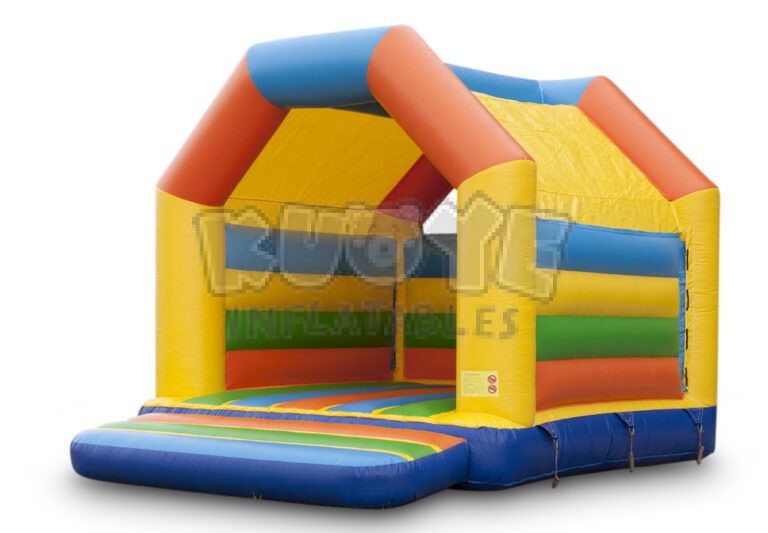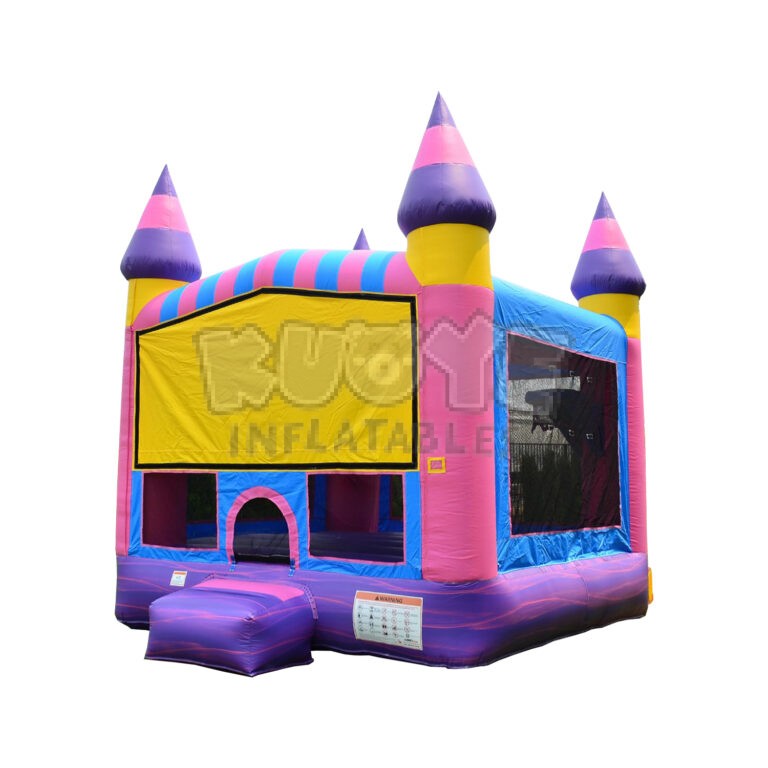Many parents and party planners often wonder about the difference between bouncy castles vs bounce houses. These colorful inflatable play structures use PVC vinyl and constant air to create strong play spaces. They offer safe jumping fun for children’s parties and events around the world. While they serve the same basic purpose, there are some interesting differences worth noting.
Key Takeaways
- Bouncy castles and bounce houses are two very similar types of inflatable play structures
- The main differences lie in design, terminology, and regional preferences
- Bouncy castle bounce house structures use similar materials and safety features
- Regional regulations have influenced different design approaches
Different Names of Bouncy Castles / Bounce Houses
The world of inflatable play structures has many different names depending on where you live. This variety in terminology sometimes confuses people who think they refer to completely different products.
In the UK, Europe, and many former British territories, people call these structures “bouncy castles” or “inflatable castles.” The names come from their original castle-like appearance with towers and walls.
In the US, your customers may know them by various names like “bounce houses,” “moonwalks,” “moon bounces,” “bouncy houses,” “bouncers,” or “jumpers.” “Bounce houses” became the most common one, possibly because early American designs focused less on castle themes and more on house-like or space-themed appearances. The name often depends on the specific design or shape of the inflatable.
In Australia, they use “jumping castles,” or simply “jumps.” This name reflects the bouncing action that makes these structures so fun for children.
In Africa, people commonly use “bouncing castles” as their preferred term.
In most parts of the world outside these regions, “bouncy castle” remains the more common term. This global preference may reflect the international influence of British English in many countries.
The variety in naming shows how these fun structures have spread globally and adapted to local language preferences. Each region developed its own way of describing the same basic concept.
Differences Between Bouncy Castles vs Bounce Houses
While bouncy castles and bounce houses are often seen as the same thing, some notable differences exist in design and regional regulations, particularly in the US and UK/Europe.
The varying designs of bouncy castle vs bounce house reflect different regulatory approaches.
Open vs. Enclosed Design
UK/European “Bouncy Castle” Design:

- Open-Front Design: European bouncy castles typically feature three fully inflated walls with an open front entrance area.
- Safety Mats: They utilize foam “crash mats” extending from the open entrance to catch children who may jump or fall out.
- Direct Supervision: The open design allows for direct visual supervision and easier adult intervention.
- Entry/Exit Management: The EN 14960-1 standard requires specific step/ramp designs that cover the entire access aperture with overlap, with a tread depth at least 1.5 times the height of the adjacent playing area platform.
- Maximum Fall Height: The European standard limits the free height of fall on open sides to 600mm (about 23.6 inches) in the loaded condition.
The open-front design allows better air circulation and makes supervision easier for adults. Parents can clearly see inside the structure and children can move in and out freely.
US “Bounce House” Design:

- Enclosed Design: American bounce houses typically feature a more enclosed structure with four walls.
- Mesh/Netting Walls: The US design often incorporates netting or mesh walls that allow for airflow and visibility.
- Smaller Entrance: Entrances tend to be more contained and controlled compared to the fully open European design.
- Containment Priority: ASTM F2374 emphasizes full perimeter containment, stating that “inflatable bounce house areas shall be fully enclosed with a perimeter barrier around all sides structurally tied together.”
- Emergency Exit: Requires a secondary escape opening in the roof, with a minimum size requirement of 400 in² (about 0.26 m²).
This enclosed design helps keep children safely inside while still allowing visibility.
Both options provide great fun and exercise but adhere to different safety standards. These structures can also include combination units with slides or obstacle games, though the primary structural differences still exist.
Other Regional Preferences
Outside of US and UK/Europe, the different terminology does not indicate actual design differences and can mean both the American and European styles of inflatable play structures.
In Australia, the AS 3533.4.1 standard represents something of a middle ground between European and American approaches to inflatable amusement device design. While Australian jumping castles share the open-front design with European models, they incorporate more detailed containment requirements for the enclosed types.
Manufacturers today produce designs specifically for different markets, but many structures work equally well regardless of regional preferences. The choice often comes down to local marketing and customer expectations.
Similarities The Two Types Share
Despite different names and some design variations, bouncy castles and bounce houses share many important features. These similarities make them essentially the same type of product with the same core purpose.
Shared Purpose and Uses
Bouncy castles and bounce houses serve the same fun purpose in children’s entertainment. Both provide a safe, fun environment for kids to jump, bounce, and play together. Party planners rent these structures for birthday parties, school events, community festivals, and family gatherings.
Both types require adult supervision and proper setup procedures. Safety guidelines apply equally to both bouncy castles and bounce houses.
Materials and Construction
Commercial-grade Inflatable bounce houses and bouncy castles need strong materials. These units use thick PVC-coated tarpaulin (vinyl) stitched with heavy-duty thread. These materials can handle constant jumping and bouncing without easily tearing, resist punctures, and withstand outdoor weather conditions.
The construction process remains similar regardless of the design. Both types have an air-filled bouncing platform. Both use reinforced seams and safety features like walls or barriers. Both should have anchor points for securing to the ground and age-appropriate weight limits. This helps contain children safely within the play area while allowing parents to watch their kids play.
Sizes and blower requirements for both types are also similar. Each inflatable stays inflated using air blowers, usually powered by electricity—about 1.5 to 2 horsepower is standard for a typical medium-sized structure. Air blowers continuously pump air into the structure to maintain proper inflation. This constant airflow keeps the bouncing surface firm yet safe for children. Inside the inflatable, baffling chambers guide airflow to keep its shape tight and safe.
Always check that your supplier uses industry standards so your inflatables run smoothly without sudden problems from bad construction.
Conclusions
Bouncy castles and bounce houses are quite alike in terms of inflatable play equipment. The primary distinction between the two lies in whether they are fully enclosed or open on one side.
Both inflatable structures use similar materials, construction methods, and safety features.
The regulatory differences create noticeably different appearances between European and American inflatable bouncers, making the inflatable play industry more interesting and diverse.
Understanding these similarities and differences helps event planners make better decisions when purchasing inflatable play equipment. The most important factors remain compliance with safety standards, quality, and choosing the right size for the age group of your events.
When choosing between the terminology, consider using local terms to connect better with your audience.
FAQs
1. What is the main difference between a bouncy castle and a bounce house?
European Bouncy Castles (EN 14960-1): These typically feature an open-front design with three air-filled walls and a large entrance step or ramp, wide enough to cover the entire aperture.
American Bounce Houses (ASTM F2374): These often feature a more enclosed design commonly utilizing mesh side walls. These structures typically have a smaller entrance and provide more containment for active children.
2. Are bouncy castles and bounce houses the same thing?
Technically, these terms refer to similar but not identical inflatable play structures. However, they are often used interchangeably across different regions.
3. Should I choose bouncy castles or bounce houses for my rental business?
It depends on where you operate your business. If you’re in the US, stick with the enclosed types that can get you insurance coverage. If you’re in the UK or Europe, you can’t go wrong with the open types. Outside these regions, the distinction between the two becomes less clear. You may want to conduct detailed market research in your area and choose the ones that appeal the most to your audience.






